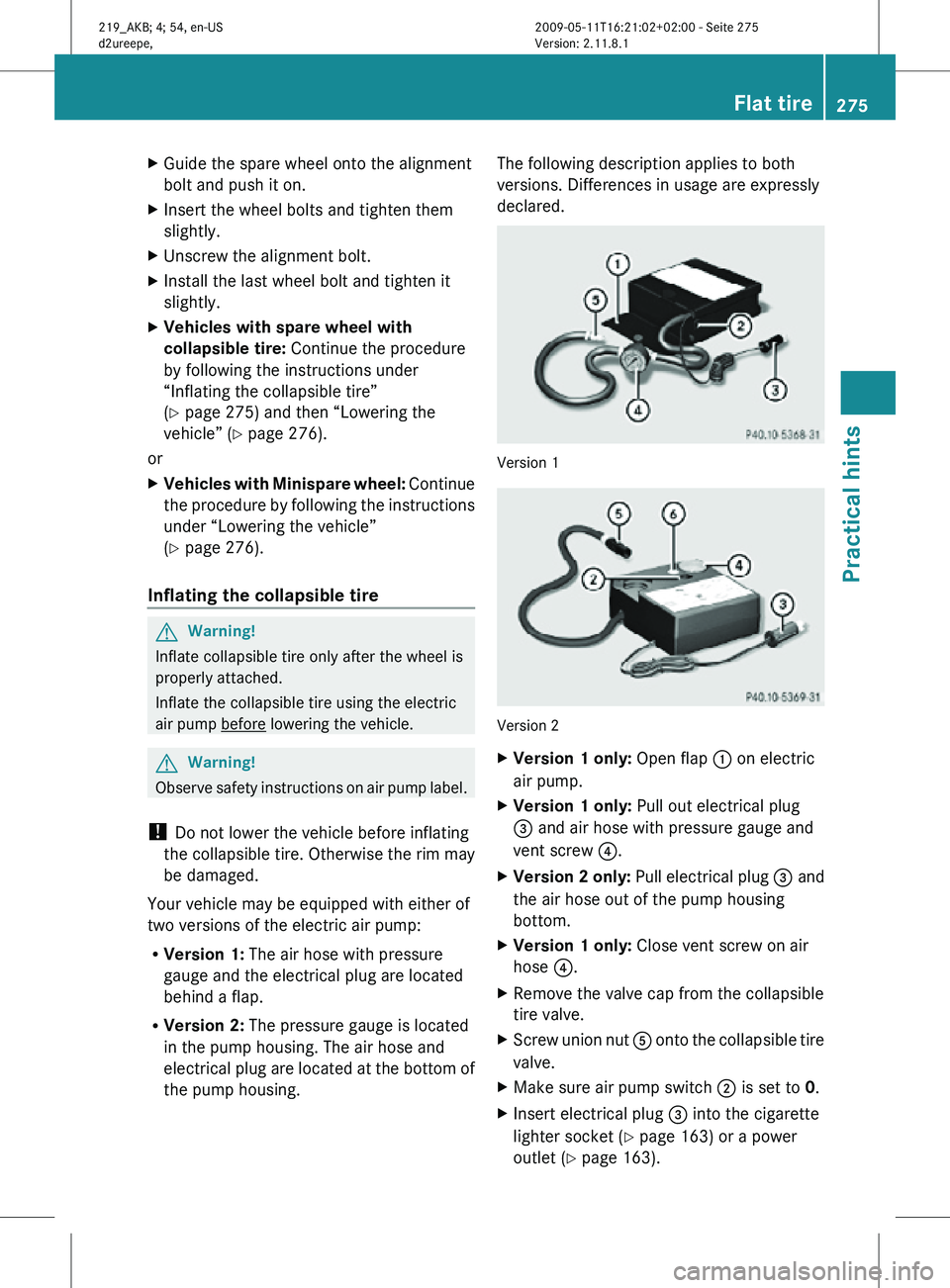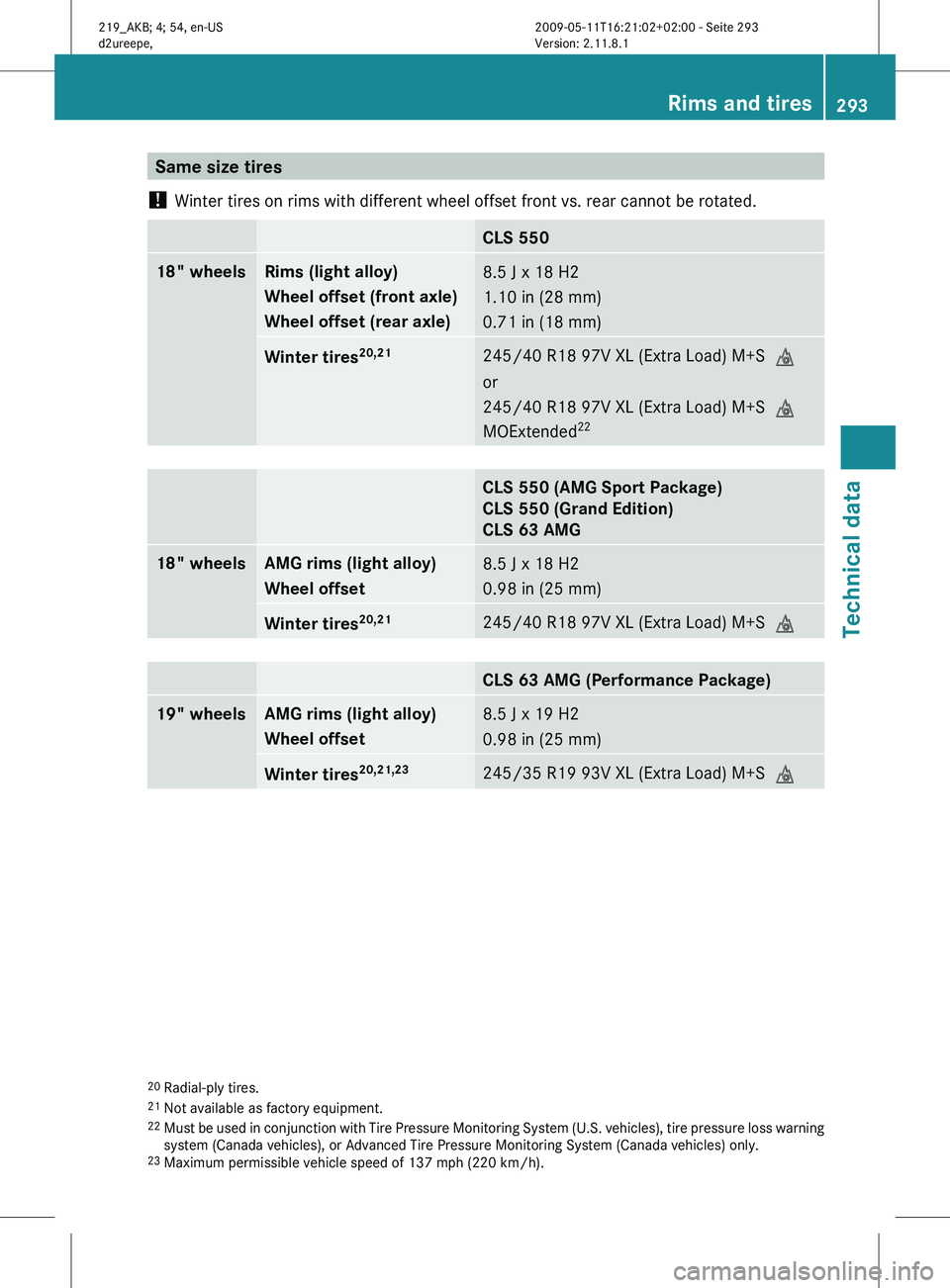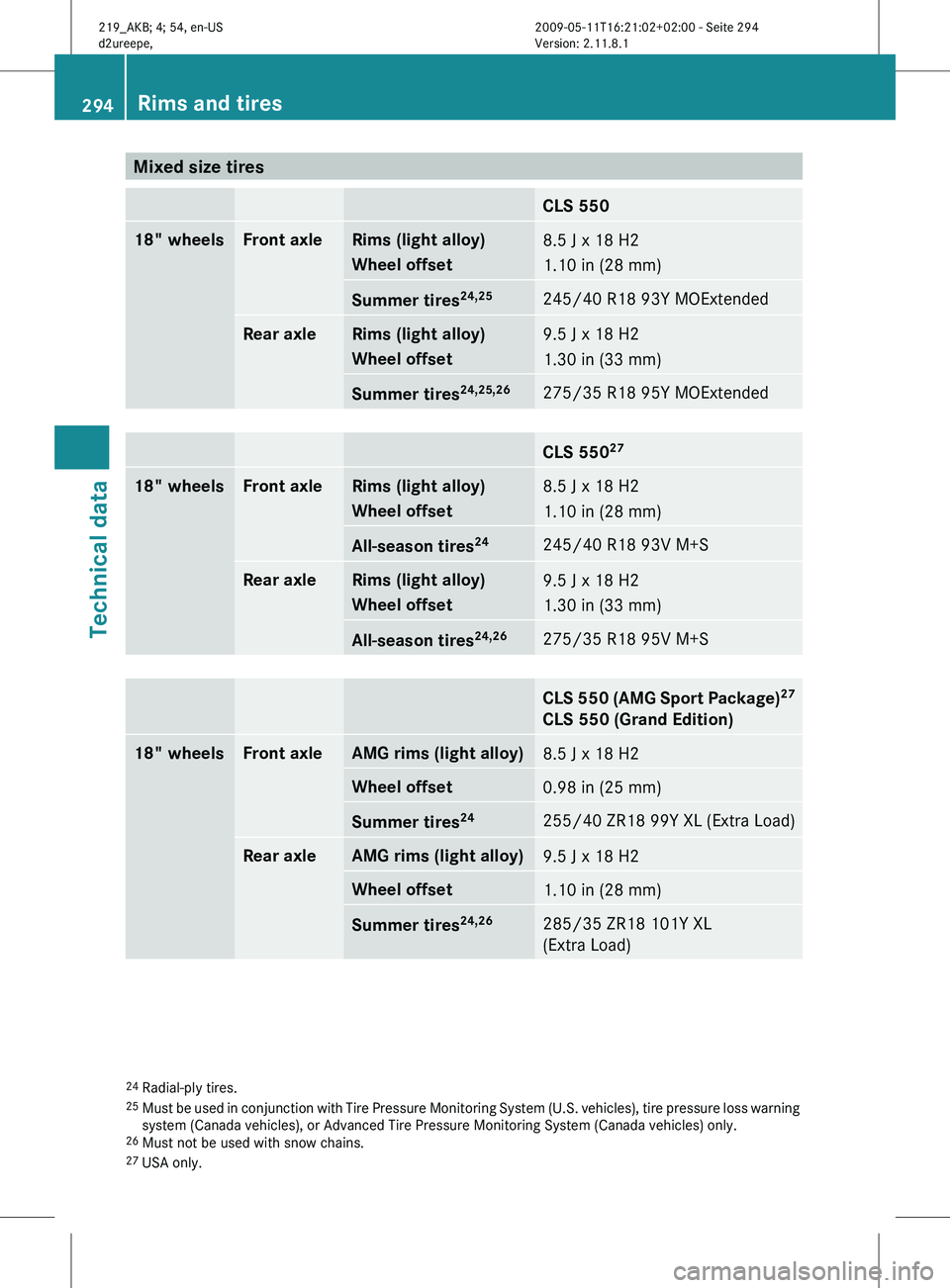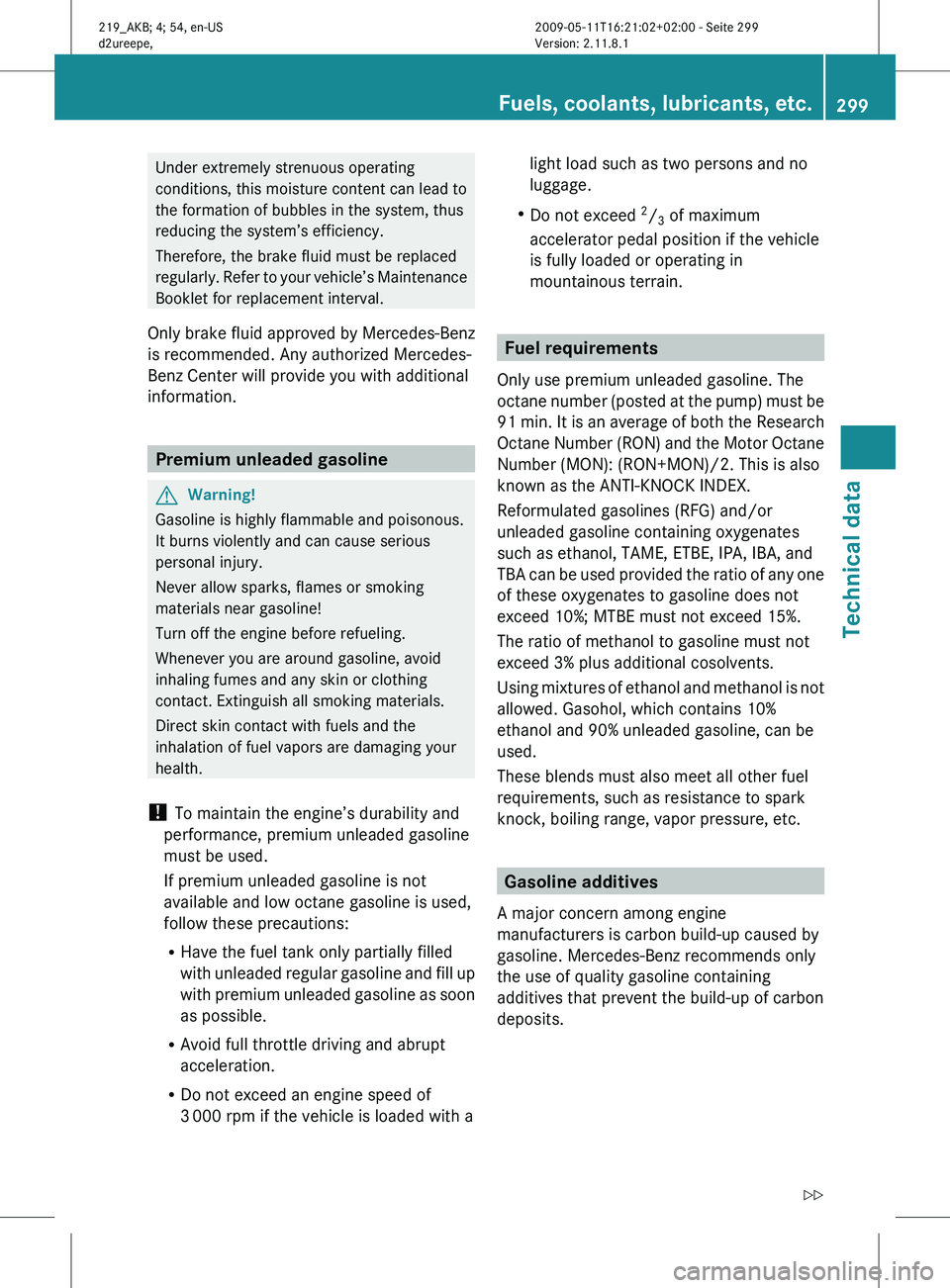2010 MERCEDES-BENZ CLS warning light
[x] Cancel search: warning lightPage 277 of 308

X
Guide the spare wheel onto the alignment
bolt and push it on.
X Insert the wheel bolts and tighten them
slightly.
X Unscrew the alignment bolt.
X Install the last wheel bolt and tighten it
slightly.
X Vehicles with spare wheel with
collapsible tire: Continue the procedure
by following the instructions under
“Inflating the collapsible tire”
(Y page 275) and then “Lowering the
vehicle” ( Y page 276).
or
X Vehicles with Minispare wheel: Continue
the procedure by following the instructions
under “Lowering the vehicle”
(Y page 276).
Inflating the collapsible tire G
Warning!
Inflate collapsible tire only after the wheel is
properly attached.
Inflate the collapsible tire using the electric
air pump before lowering the vehicle.
G
Warning!
Observe safety instructions on air pump label.
! Do not lower the vehicle before inflating
the collapsible tire. Otherwise the rim may
be damaged.
Your vehicle may be equipped with either of
two versions of the electric air pump:
R Version 1: The air hose with pressure
gauge and the electrical plug are located
behind a flap.
R Version 2: The pressure gauge is located
in the pump housing. The air hose and
electrical plug are located at the bottom of
the pump housing. The following description applies to both
versions. Differences in usage are expressly
declared.
Version 1
Version 2
X
Version 1 only: Open flap : on electric
air pump.
X Version 1 only: Pull out electrical plug
= and air hose with pressure gauge and
vent screw ?.
X Version 2 only: Pull electrical plug = and
the air hose out of the pump housing
bottom.
X Version 1 only: Close vent screw on air
hose ?.
X Remove the valve cap from the collapsible
tire valve.
X Screw union nut A onto the collapsible tire
valve.
X Make sure air pump switch ; is set to 0.
X Insert electrical plug = into the cigarette
lighter socket ( Y page 163) or a power
outlet (Y page 163). Flat tire
275Practical hints
219_AKB; 4; 54, en-US
d2ureepe, Version: 2.11.8.1 2009-05-11T16:21:02+02:00 - Seite 275 Z
Page 295 of 308

Same size tires
! Winter tires on rims with different wheel offset front vs. rear cannot be rotated. CLS 550
18" wheels Rims (light alloy)
Wheel offset (front axle)
Wheel offset (rear axle)
8.5 J x 18 H2
1.10 in (28 mm)
0.71 in (18 mm)
Winter tires
20,21 245/40 R18 97V XL (Extra Load) M+S
i
or
245/40 R18 97V XL (Extra Load)
M+Si
MOExtended 22 CLS 550 (AMG Sport Package)
CLS 550 (Grand Edition)
CLS 63 AMG
18" wheels AMG rims (light alloy)
Wheel offset
8.5 J x 18 H2
0.98 in (25 mm)
Winter tires
20,21 245/40 R18 97V XL (Extra Load) M+S
i CLS 63 AMG (Performance Package)
19" wheels AMG rims (light alloy)
Wheel offset
8.5 J x 19 H2
0.98 in (25 mm)
Winter tires
20,21,23 245/35 R19 93V XL (Extra Load) M+S
i20
Radial-ply tires.
21 Not available as factory equipment.
22 Must
be used in conjunction with Tire Pressure Monitoring System (U.S. vehicles), tire pressure loss warning
system (Canada vehicles), or Advanced Tire Pressure Monitoring System (Canada vehicles) only.
23 Maximum permissible vehicle speed of 137 mph (220 km/h). Rims and tires
293
Technical data
219_AKB; 4; 54, en-US
d2ureepe, Version: 2.11.8.1 2009-05-11T16:21:02+02:00 - Seite 293 Z
Page 296 of 308

Mixed size tires
CLS 550
18" wheels Front axle Rims (light alloy)
Wheel offset
8.5 J x 18 H2
1.10 in (28 mm)
Summer tires
24,25 245/40 R18 93Y MOExtended
Rear axle Rims (light alloy)
Wheel offset
9.5 J x 18 H2
1.30 in (33 mm)
Summer tires
24,25,26 275/35 R18 95Y MOExtended
CLS 550
27 18" wheels Front axle Rims (light alloy)
Wheel offset
8.5 J x 18 H2
1.10 in (28 mm)
All-season tires
24 245/40 R18 93V M+S
Rear axle Rims (light alloy)
Wheel offset
9.5 J x 18 H2
1.30 in (33 mm)
All-season tires
24,26 275/35 R18 95V M+S
CLS 550 (AMG Sport Package)
27
CLS 550 (Grand Edition) 18" wheels Front axle AMG rims (light alloy)
8.5 J x 18 H2
Wheel offset
0.98 in (25 mm)
Summer tires
24 255/40 ZR18 99Y XL (Extra Load)
Rear axle AMG rims (light alloy)
9.5 J x 18 H2
Wheel offset
1.10 in (28 mm)
Summer tires
24,26 285/35 ZR18 101Y XL
(Extra Load)
24
Radial-ply tires.
25 Must
be used in conjunction with Tire Pressure Monitoring System (U.S. vehicles), tire pressure loss warning
system (Canada vehicles), or Advanced Tire Pressure Monitoring System (Canada vehicles) only.
26 Must not be used with snow chains.
27 USA only. 294
Rims and tires
Technical data
219_AKB; 4; 54, en-US
d2ureepe,
Version: 2.11.8.1 2009-05-11T16:21:02+02:00 - Seite 294
Page 298 of 308

Spare wheel
! Compare the recommended tire inflation pressure for your vehicle with the tire inflation
pressure on the yellow label located on the spare wheel rim.
If
the tire inflation pressure on the yellow label on the spare wheel rim differs from the values
given in this Operator’s Manual, inflate the tire to the recommended tire inflation pressure
given on the yellow label on the spare wheel rim.
i Please note that the tire inflation pressure of the spare wheel differs from the tire inflation
pressure of the road tires. CLS 550 (all models) CLS 63 AMG CLS 63 AMG
(Performance Package)
Rim (steel)
Wheel offset
4.0 B x 17 H2
1.34 in (34 mm) — —
Rim (light alloy)
Wheel offset
— 6.0 B x 18 H2
0.98 in (25 mm) 6.5 B x 19 H2
0.55 in (14 mm)
Minispare tire
32 T 155/70 R17 110M — —
Collapsible tire
32 — 175/55-18 95P 175/50-19 97P
Recommended
tire inflation
pressure
61 psi (4.2 bar) 51 psi (3.5 bar) 51 psi (3.5 bar)
Fuels, coolants, lubricants, etc.
Capacities
Vehicle components and their respective
lubricants must match. Therefore only use
products tested and approved by Mercedes-
Benz.
For information on tested and approved
products, contact an authorized Mercedes-
Benz Center or visit www.mbusa.com (USA
only). G
Warning!
Comply with all valid regulations with respect
to handling, storing, and disposing of service fluids. Otherwise you could endanger persons
or the environment.
Keep service fluids out of the reach of
children.
For health reasons, you should prevent
service
fluids from coming into direct contact
with your skin or clothing.
If a service fluid is swallowed, contact a
physician immediately.
32 Must not be used with snow chains. 296
Fuels, coolants, lubricants, etc.
Technical data
219_AKB; 4; 54, en-US
d2ureepe,
Version: 2.11.8.1 2009-05-11T16:21:02+02:00 - Seite 296
Page 301 of 308

Under extremely strenuous operating
conditions, this moisture content can lead to
the formation of bubbles in the system, thus
reducing the system’s efficiency.
Therefore, the brake fluid must be replaced
regularly.
Refer to your vehicle’s Maintenance
Booklet for replacement interval.
Only brake fluid approved by Mercedes-Benz
is recommended. Any authorized Mercedes-
Benz Center will provide you with additional
information. Premium unleaded gasoline
G
Warning!
Gasoline is highly flammable and poisonous.
It burns violently and can cause serious
personal injury.
Never allow sparks, flames or smoking
materials near gasoline!
Turn off the engine before refueling.
Whenever you are around gasoline, avoid
inhaling fumes and any skin or clothing
contact. Extinguish all smoking materials.
Direct skin contact with fuels and the
inhalation of fuel vapors are damaging your
health.
! To maintain the engine’s durability and
performance, premium unleaded gasoline
must be used.
If premium unleaded gasoline is not
available and low octane gasoline is used,
follow these precautions:
R Have the fuel tank only partially filled
with
unleaded regular gasoline and fill up
with premium unleaded gasoline as soon
as possible.
R Avoid full throttle driving and abrupt
acceleration.
R Do not exceed an engine speed of
3 000 rpm if the vehicle is loaded with a light load such as two persons and no
luggage.
R Do not exceed 2
/ 3 of maximum
accelerator pedal position if the vehicle
is fully loaded or operating in
mountainous terrain. Fuel requirements
Only use premium unleaded gasoline. The
octane
number (posted at the pump) must be
91 min. It is an average of both the Research
Octane Number (RON) and the Motor Octane
Number (MON): (RON+MON)/2. This is also
known as the ANTI-KNOCK INDEX.
Reformulated gasolines (RFG) and/or
unleaded gasoline containing oxygenates
such as ethanol, TAME, ETBE, IPA, IBA, and
TBA can be used provided the ratio of any one
of these oxygenates to gasoline does not
exceed 10%; MTBE must not exceed 15%.
The ratio of methanol to gasoline must not
exceed 3% plus additional cosolvents.
Using mixtures of ethanol and methanol is not
allowed. Gasohol, which contains 10%
ethanol and 90% unleaded gasoline, can be
used.
These blends must also meet all other fuel
requirements, such as resistance to spark
knock, boiling range, vapor pressure, etc. Gasoline additives
A major concern among engine
manufacturers is carbon build-up caused by
gasoline. Mercedes-Benz recommends only
the use of quality gasoline containing
additives that prevent the build-up of carbon
deposits. Fuels, coolants, lubricants, etc.
299
Technical data
219_AKB; 4; 54, en-US
d2ureepe, Version: 2.11.8.1 2009-05-11T16:21:02+02:00 - Seite 299 Z